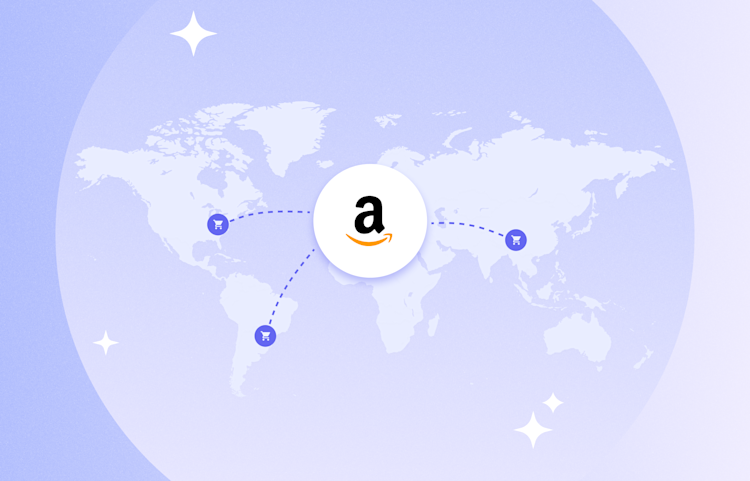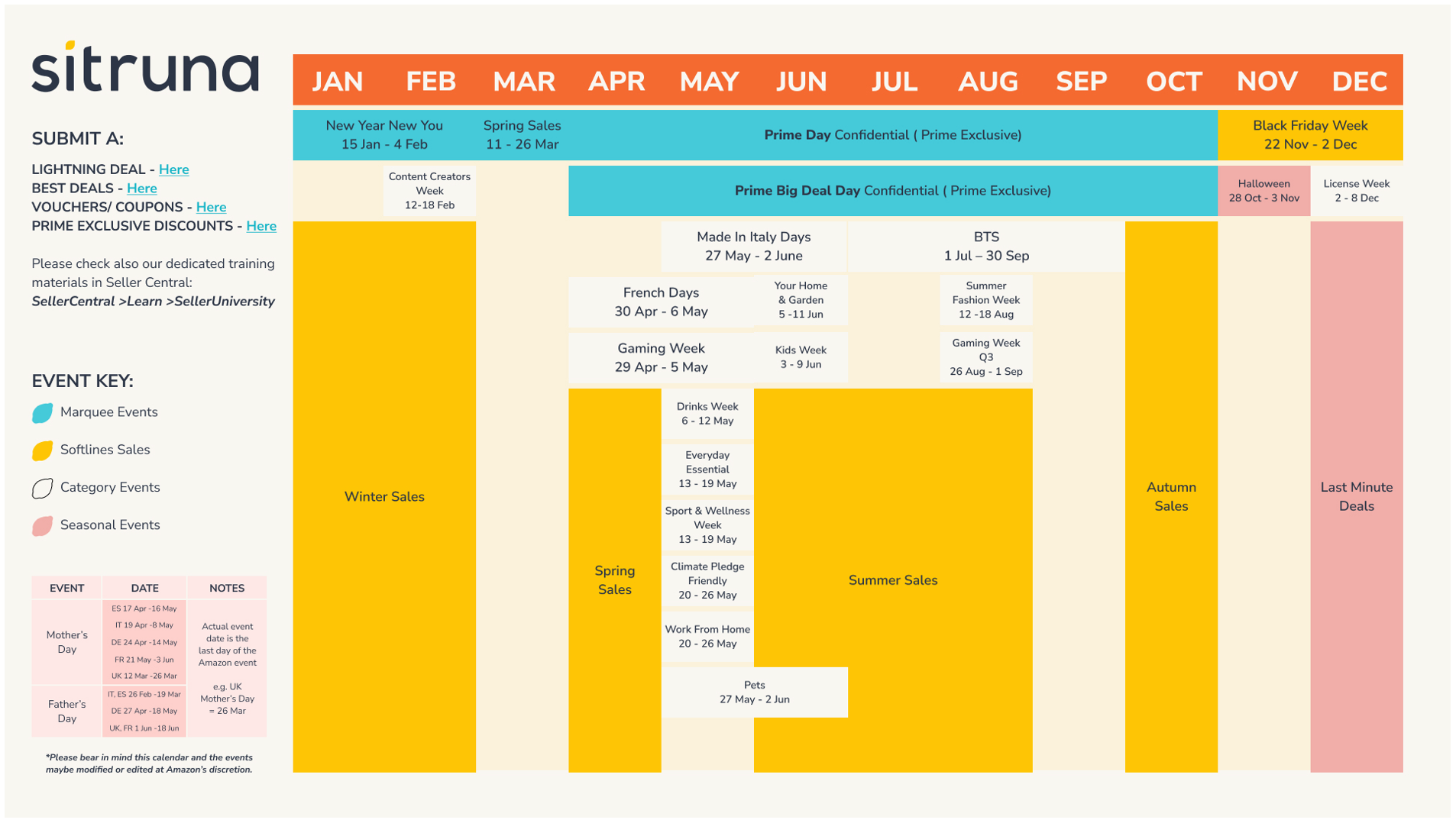
Navigating regional shopping nuances on Amazon
Victoria Leighton, August 9, 2024
Introduction
Amazon has grown into a powerhouse of global commerce, reshaping how consumers shop and businesses sell. But simply listing products on Amazon isn't enough. To be successful, you must adhere to compliance variations and understand the regional shopping nuances that influence consumer behavior and sales performance. Recognizing that cultural preferences, economic conditions, and technology adoption differ vastly between regions, is key. Adapting product listings and promotional strategies to local preferences can lead to increased visibility, higher conversion rates, and ultimately, greater success in Amazon's competitive marketplace.
Understanding regional differences in Amazon shopping behaviors
Regional peaks in online sales: Key events and opportunities
Looking back at 2022-23 online shopping trends reveal a fascinating tapestry of consumer behaviors across regions:
Aligning inventory and promotional activities with these occasions can significantly boost sales performance. See below for a promotional calendar for the UK (please note, that calendars are different per region, for instance, Mother’s Day falls on a different day in the U.S.).

Comparing the eCommerce titans
Knowing the competition is key within the global eCommerce landscape: Chinese retail giant Alibaba currently leads the pack with a commanding 23% market share. However, the horizon looks bright for Amazon. Projections indicate that by 2027, Amazon will outpace Alibaba, achieving an astonishing $1.2 trillion in online sales. Meanwhile, in Europe, players like Zalando and Otto pose formidable competition with their stronghold in fashion and home goods. In the U.S., Walmart’s expanding online presence continues to challenge Amazon’s dominance.
Evolving consumer preferences
Shopping behaviors vary significantly in the culturally diverse EMEA (Europe, the Middle East, and Africa) region. European consumers place a premium on quality and brand reputation, driving sales in categories such as electronics, fashion, and home goods. Meanwhile, the Middle East shows a strong preference for luxury items and beauty products. Africa shows a growing inclination towards mobile commerce. Although desktop users remain significant in America and Europe, rising mobile and app shopping rates mean optimizing listings for mobile is essential. It’s important to stay ahead of emerging trends, economic conditions, or political factors that might affect consumer spending. For example, during economic downturns, essentials may take precedence over luxury items. Monitoring economic indicators helps sellers anticipate shifts in demand.
Strategies for successful international expansion
Conduct market research
Successful global market or category entry is always underpinned by market research. Leveraging Amazon’s tools such as Brand Analytics is a good start, but you can obtain in-depth data and visual analysis from 3rd party tools such as Google Trends (free) or Perpetua. Use these tools to identify product demand, keywords, and customer preferences within your target category or region.
Choose the right Amazon model
Amazon’s 1P (first-party) and 3P (third-party) models offer different advantages by region. American and European sellers benefit from 3P flexibility and brand control. In APAC, 1P can enhance local market penetration through Amazon’s distribution. In Southeast Asia, a hybrid approach combining 1P for market entry and 3P for brand expansion can optimize sales performance. Understanding the regional impacts of these models can guide strategic decisions.
Time your launch for maximum impact
When considering the best time for launching a product or brand, consider categories and markets more broadly. Target peak seasonal events within the category you are launching. For example, if you’re launching a box of chocolates you’ll want to be live for Valentine’s Day; if you’re launching a range of cool boxes it makes sense to do this for the summer months. If you’re unsure when to launch, conducting market research can help, but you can’t go too wrong if you aim for Amazon’s biggest quarter - Q4. Once you’ve identified the ideal launch period, make sure to get your optimized listing live in advance, and ramp up advertising spend for fruitful results.
Smart pricing and bundling
Pricing strategies must reflect regional preferences. American consumers often seek deals and discounts, while European shoppers may prioritize value for money and quality. In APAC, price sensitivity can be more strongly influenced by economic fluctuations and market competition from platforms like Alibaba. Product bundling should also align with regional preferences. North American shoppers often look for value deals, while European consumers appreciate bundled products with complementary items.
Regionally optimizing product listings
Crafting content that converts
Consumers have different content expectations based on each region. To create content that engages the regional audience, you need to ensure that it is relevant to them. For example, in our experience, we find that:
American consumers prefer shorter descriptions and high-quality images.
European shoppers value comprehensive product information and localized content.
APAC shoppers often look for multimedia content, tailored to mobile viewing.
Capturing the local audience
Consumer search behavior on Amazon varies widely by region. American shoppers often use broad search terms, while European and APAC consumers lean towards specific, localized phrases. Because of this, localizing product listings is crucial to boost customer engagement and drive sales. Translating listings accurately and including local idioms, not only ensures your listings are accessible to shoppers in that region but will likely result in better search ranking and conversion. Avoid relying on Google Translate or other free tools, as they often lead to inaccurate translations. Instead, we recommend enlisting the help of translation service providers with native SEO-trained copywriters who will ensure localization is accurate and contextually relevant.
Cultivating global brand loyalty
Achieving consistent brand representation across borders is vital to retaining brand loyalty and customer trust. Consumers in APAC, especially in Japan and South Korea, value brand heritage and authenticity. In order to foster global brand loyalty, maintain a consistent tone of voice, clear brand messaging, and on-brand graphics.
Understanding compliance and logistics
Ensuring regulatory compliance across borders
Compliance with regional pricing regulations and VAT and customs requirements is crucial. There is a complex landscape of indirect tax regulations that vary by region. Navigating these is essential for compliance, avoiding penalties, and maintaining profitability. Amazon's VAT Calculation Service simplifies this process for sellers operating in Europe, where requirements are extremely strict. Outside of Europe, working with a partner like Taxually can simplify tax compliance across multiple markets.
Further, navigating regional regulations on product safety, labeling, and sustainability safeguards brand reputation. All EU member states are legally required to report on their implementation of the EU waste laws to the European Commission. Germany is probably the strictest market in this aspect, as they have required a PRN (Product Reference Number) to trade online since 2022. This is a complex topic, but there are plenty of tips that can help you avoid the risk of non-compliance.
Sustainability as a selling point
Shoppers are also becoming increasingly conscious and looking for more sustainable options. Aligning with regional sustainability trends will attract environmentally conscious buyers:
European consumers, particularly in Germany and Scandinavia, have a strong preference for eco-friendly products.
American shoppers increasingly value sustainable practices, though price remains a key factor.
In APAC, interest in sustainability is rising, driven by regulations and consumer awareness. In Southeast Asia, consumers show growing interest in eco-friendly packaging.
The growing emphasis on eco-friendly brands and products offers a ripe opportunity to showcase your commitment to sustainability, potentially attracting a broader customer base. Unsurprisingly, there are also many compliance hoops to jump through for eco status, with Los Angeles and Germany being some of the strictest locales.
Meeting fulfillment expectations
Regional differences in shipping and fulfillment for Amazon markets highlight the need for tailored logistics strategies to meet local expectations:
In North America, rapid fulfillment is essential, with Amazon Prime setting high standards for fast delivery. Efficient warehousing and a robust transportation network are crucial to maintaining this speed.
In Europe, the focus shifts to compliance with varying VAT and customs regulations, necessitating a detailed understanding of local requirements and the use of Amazon’s Pan-European FBA (Fulfilment by Amazon) to streamline cross-border shipping.
In the Asia-Pacific region, logistics complexity arises from diverse infrastructure capabilities and geographical challenges. Sellers benefit from leveraging Amazon’s regional fulfillment centers and partnerships with local delivery networks to navigate fragmented logistics landscapes.
Adapting advertising strategies for regional differences
Tailoring your campaigns
Achieving advertising success on Amazon demands a crafted approach to regional nuances. PPC (Pay Per Click) campaigns and keyword strategies must align with regional search behaviors. We recommend conducting region-specific keyword research using the Amazon Search Query Performance (SQP) dashboard and optimizing campaigns based on performance data can help to maximize advertising effectiveness. You can further enhance your Amazon Ads strategy with the Amazon DSP (Demand-Side Platform), which enables precise targeting based on regional shopping behaviors.
Adapting messaging to the local market
When advertising across regions, it’s important that your campaigns use local dialects and take cultural sensitivity into account. A campaign that resonates in one region might fall flat or even offend in another. For instance, a U.S. campaign highlighting individualism may not resonate with the more community-focused markets in Asia.
Leveraging the right ad format
The American market and more advanced EU marketplaces typically feature advanced advertising formats, including Sponsored Products, Sponsored Brands, and Sponsored Display ads, with an emphasis on using Amazon DSP.
It is important to adapt your bidding strategies and budget optimization accordingly. Consider that advertising acceptance policies may differ per market to comply with applicable laws and regulations.
Understand the regional competition
Conduct thorough competitor research to identify who you are competing against as your competition will vary per market. Market size will also impact the number of competitors:
The U.S. is the largest and most competitive marketplace, resulting in higher costs per click.
Brazil is the largest market in South America.
Germany and the UK are the largest in Europe, but the other EU marketplaces are rapidly catching up.
Conclusion
Navigating Amazon's global marketplace requires a nuanced understanding of regional shopping behaviors and preferences. By tailoring strategies to resonate with consumers across different regions, sellers can enhance competitiveness and drive growth. Embracing localization, optimizing advertising strategies, and ensuring compliance with regional regulations are essential components of a successful global strategy. As Amazon evolves globally, adapting to regional nuances will be pivotal for sustained success and market leadership. Sellers must stay attuned to regional shopping nuances to maximize their reach and impact.
To learn more about adaption to regional differences on Amazon, connect with the Sitruna team.
This blog was written by Victoria Leighton at Sitruna.
To get started or learn more about how Perpetua can help you scale your Amazon Advertising business, contact us at hello@perpetua.io